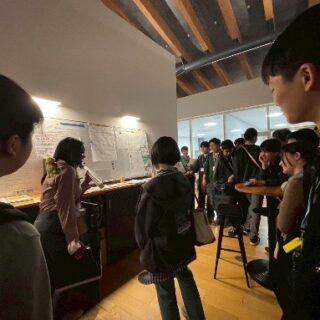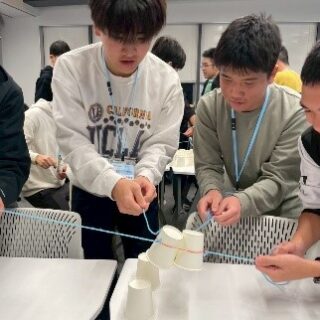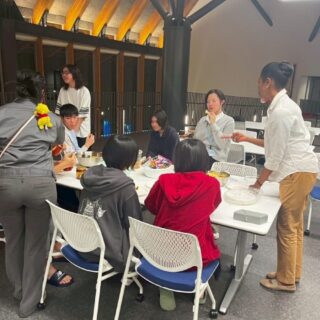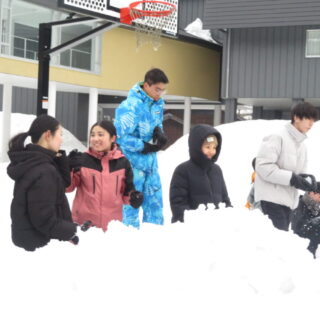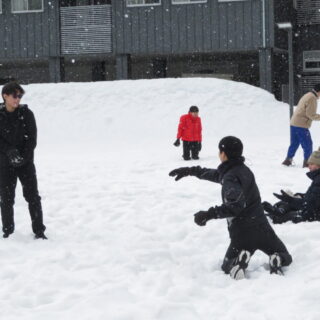Other Classes
その他の活動
 こんにちは。数学科目担当の木原 均です。2025年6月3日(火)に2年生の微分・積分の授業で行ったちょっとしたイベント「数学バトル」について紹介します。
こんにちは。数学科目担当の木原 均です。2025年6月3日(火)に2年生の微分・積分の授業で行ったちょっとしたイベント「数学バトル」について紹介します。
微分・積分の普段の授業では毎回、その日に学んだ内容に関する問題とその解答を各自がそれぞれ作成し、クラスメイトとお互いにチェックし合うという活動を行っています。今回のイベントは、ちょうど中間テスト直前ということもあり、総復習の意味も込めて、普段行っていることをチーム戦という形式で実施しました。限られた時間の中で、より多くの問題を作成し、より多くの敵チームの問題を解答したチームが勝利となります。
「数学バトル」は今回が初の試みだったのですが、学生の皆さんはとても高い集中力で取り組んでいました。敵チームに解かれないよう出来るだけ難しい問題を作成している姿や、敵チームの問題を何としてでも解こうと試行錯誤している姿はとても印象的でした。もちろん限られた短い時間だったため、作成した問題や解答に不備が見つかることもありましたが、一方でとても素晴らしい問題をいくつも作り出してくれました。以下はそのような問題の一例です。

この問題は一見とても長く複雑そうに見えますが、授業で学んだことを使えば解き方はとてもシンプルです。ただし、答えを求める際は正確な計算力が必要となります。1つの問題の中にいくつもの要素が入っている大変素晴らしい問題ですね。
数学バトル中は、作成者も解答者もみんな笑顔で楽しそうに問題に向き合い、和気あいあいとした雰囲気でした。でも不思議ですね。もし私が似たような問題を中間テストで出題したら、おそらくブーイングが鳴り止まず、殺伐とした雰囲気になると思うのですが…。それはそうと、先ほどの問題の答えは184756分の1です。すごい値ですね。うーん、やっぱり中間テストに出すのはやめておいた方が良さそうです。それではまた。
チームごとに問題を作成
敵チームの問題を解答し、問題作成者に回答を確認
木原 均
 Hello, this is Hitoshi Kihara, I am in charge of some of the Math classes at ICT. I am going to introduce the Math Battle that was held on Tuesday, June 3rd, 2025, for the 2nd year Calculus class.
Hello, this is Hitoshi Kihara, I am in charge of some of the Math classes at ICT. I am going to introduce the Math Battle that was held on Tuesday, June 3rd, 2025, for the 2nd year Calculus class.
In our regular Calculus classes, each student creates a problem and its solution based on the day’s lesson, and in pairs we check each other’s work.
This event, held just before the midterm exam, was designed as a comprehensive review. I turned our usual activity into a team-based competition. The team that created the most problems and solved the most problems from the opposing team within the limited time would be the winner.
This was my first attempt at holding a Math Battle, but the students participated with remarkable focus and enthusiasm.
It was impressive to see them trying to create problems that were as challenging as possible so the opposing team couldn’t solve them. Also, it was impressive to see their determination as they worked through the other team’s problems, attempting to solve them by trial and error.
Of course, due to the limited time, some problems and solutions had minor flaws. However, many students also came up with truly excellent problems.
Below is an example of one such problem.

At first glance, this problem may look long and complicated, but if they apply what we've learned in class, the solution is actually quite simple. That said, solving it does require accurate calculation skills. It’s a truly excellent problem, packed with multiple mathematical elements within just one question.
During the Math Battle, there was a friendly and lively atmosphere with both the problem creators and solvers being all smiles. But it’s funny, isn’t it? If I gave a similar problem on the midterm exam, I’m pretty sure I’d be met with endless complaints and a much more brutal atmosphere. Anyway, the answer to the earlier problem is 1 over 184,756. What an incredible number! Hmm … maybe I’d better not include it on the midterm after all. Well then, until next time!
Create problems for each team
Solve the problem created by the opposing team and have the original creators check your answer
Hitoshi Kihara

こんにちは!今年度から白山麓キャンパス、ラーニングメンターの一員になったシャルミー・アブワンです。私は大学で情報技術を学び、フィリピンで数年間、ネットワーク設定、データ処理、システム開発などの仕事に携わりました。
白山麓キャンパスでは、学生が宿題やプロジェクトに取り組んだり、英語の練習をしたりするラーニングセッションを夜に開催しています。ラーニングメンターは、学生がサポートや指導を必要とするときはいつでもサポートをします。私の主な仕事は夜に行われるラーニングセッションですが、そのために午後から通常の授業にも参加して、学生が授業でどのように学習しているかを観察し、より深く理解します。私は自分のITのバックグラウンドを使って、学生がコンピューター関連の問題を抱えたり、オンライン・ツールに行き詰まったりしたときに、解決策を見つける手助けをしたいと思っています。
ラーニングメンターになって1か月が経ち、他のラーニングメンターや、学生たちから学んだ出来事がいくつかありましたので紹介したいと思います。ラーニングメンターとして成長するために、どんなスキルが必要なのかを考えるきっかけとなった出来事です。
- コミュニケーションのコツ
学生たちは現在、ラーニングセッションでSRAと呼ばれる自主学習型のリーディングプログラムに取り組んでいます。このプログラムは、各学生が適切なレベルで学習し、自分のペースで学習を進めることができるようにするためのものです。私たちは、学生と会話する際に、学習した単語や内容について話すように心がけています。そうすることにより、学生たちの英語学習の強化につながることを期待しています。 - 一緒に、そして一人で
ある日のラーニングセッシで、学生がコンピュータースキルズの宿題を手伝ってほしいとやって来ました。他のラーニングメンターのように、初めは共に座り、一つずつ教えながら取り組みました。私は自分のパソコンでどのようにやるかを見せて、学生たちが理解できるようにしました。その後、自分で取り組んでもらい、出来るようになっている姿をみることができました。一緒に、その後一人で出来る様子はいつも嬉しく思います。 - 助け合えば上手くいく
ラーニングセッションの時間では、学生たちはお互いに助け合う場面もあります。学生同士が一緒に座り、学校について話し合う様子は素晴らしいです。例えば、その日に出された難しいクイズを解くために、お互いにヒントやコツを学び合う様子です。
学生たちと過ごす時間、特に夜に行われる2時間のラーニングセッションの時間では、毎回新たな学びがあります。より良いサポートをする方法が少しずつ分かるようになってきました。
初めてラーニングメンターの仕事内容を聞いた時、学生の成長のサポートにとどまらず、自分自身の成長にも繫がるように思えてワクワクしました。学生をサポートしながら一緒に学んでいけることにやりがいを感じています。新学期が始まって1ヶ月以上経ち、学生たちが徐々に心を開いてきていることを感じます。1年生は、新しい環境に慣れていく途中ではありますが、どんどんと自信をつけてきていますし、一方で2年生は成長し、1年生を助けるなど活躍しています。
私も新入生のように、この新たな環境に慣れているところです。最初のこの1年は、学生たちが学ぶ多くの科目、特にコンピューター関連の科目を学び、ラーニングメンターとして成長していきたいと考えています。そして今後も学生たちによりよいサポートができればと思っています。
シャルミー・アブワン
 Hello! I’m Sharmee Abuan, a new Learning Mentor (LM) at Hakusanroku Campus. I studied Information Technology in university and spent several years working in the field, doing tasks related to network configuration, data transactions, and system development in the Philippines.
Hello! I’m Sharmee Abuan, a new Learning Mentor (LM) at Hakusanroku Campus. I studied Information Technology in university and spent several years working in the field, doing tasks related to network configuration, data transactions, and system development in the Philippines.
At Hakusanroku Campus, we hold Learning Sessions (LS) in the evening where students work on their homework, projects, or practice their English. LM are there to help out whenever students need support or guidance. While my main role is during LS time, I also join afternoon classes to observe and get a better idea of how students learn in class. I am hoping to use my IT background to help students figure out solutions to their tasks, when they have computer-related issues or get stuck with online tools.
In my first month of working, I have encountered several teachable moments while interacting with other LM’s and students and I hope to share them here. Little moments that make me reflect on what skills I still need to work on to hopefully become an effective LM.
1. The Communication Trick - The students are currently doing a self-guided reading program that ensures each student is learning at the appropriate level and advancing at their optional pace called SRA during LS and we try to bring up the learned words and content when chatting with them. This, hopefully, would help reinforce their language skills.
2. I do, We do, You do - One evening during LS, a student came over and asked for help with their Computer Skills homework. As I have observed from what other LM’s do, we sat down together and worked through the task step by step at first. I showed them how it’s done on my laptop so they could follow along. Afterwards, we ask them to do it by themselves and it is always nice to see when they can finally work independently.
3. Working Together Works - At LS, students also get the chance to help each other. It is amazing to see students sitting together and talking about school. For example, trying to solve that one challenging quiz of the day and learning tips and tricks from each other.
I learn something new each time I work with the students, especially during the two hours I spend with them in the evening at LS. Little by little, it’s helping me understand how to support them better.
When I first heard about what LM’s do, the possibilities for growth not only on the students’ side but also for my personal growth made me feel excited. It felt like I’d be learning alongside the students as I support them, and that idea really motivated me. Now that more than a month has passed since the semester started, I’ve seen students gradually open up. The first-year students are still adjusting to their new environment but are becoming more confident, while the second-year students are stepping up and even helping their juniors.
Right now, I’m still in the process of adjusting and learning, just like the students. I plan to use this first year to grow by studying many of the subjects they’re learning, especially the computer-related ones, and by observing what makes an effective LM. I hope that by doing so, I can support the students even better in the years to come.
Sharmee Abuan
こんにちは、英語科目担当のポーリン・ベアードです。
あなたが持ち主でありながら、他の人の方がよく使うものは何でしょう?
そう、あなたの名前です!
授業の初日、学生たちに緊張感が漂っています。保護者の方も同じ思いで過ごされているのではないでしょうか。国際高専 では授業は英語で行われます。「ブリッジイングリッシュ・化学」の授業で「私の名前は…」というアイスブレイクを始めたところ、静まり返っていた教室は活気に溢れ、学生たちは大きな声と笑いに包まれました。
私の名前
「私の名前はトシムネです。私はトシ_、兄はトシ_、父はトシ_、祖父はトシ_。私の家族の男性は皆名前に『トシ』がつきます。」ある学生が名前についてのストーリーをシェアしてくれました。彼はストーリーを丁寧な英語で書き、そして嬉しそうに発表してくれたことにより、張りつめていた授業の雰囲気は一変しました。

 アクティブ・ラーニング
アクティブ・ラーニング
初めに、ペアを組んでアクティビティを始めました。学生たちは2人で1つのホワイトボードを共有しお互いの名前を書きだしました。ペアを組んで共に課題に取り組むことにより、お互い出会って間もない学生同士が打ち解けるきっかけになります。
学生たちに、あなたの名前を漢字で紹介してくださいと言うと、学生たちは戸惑いの表情を見せました。私にとって彼らの名前の漢字を読めませんでしたが、それでも漢字で名前を書いてもらいました。ペアで取り組むことで、学生たちの友情を築き、学生と教員が英語を学んだり教えたりする際に必要な体験を共有することに役立ちます。
次の課題は、自分の名前の意味や、その名前の由来について話すことでした。一人の学生はすぐに「知ってる、知ってる」と言って、ホワイトボードに丁寧な英語を書いて説明してくれました。名前の意味に関するジョークまでも話してくれました。また他の学生たちは、名前の由来を知らなかったので、私は
「お母さんに聞いてごらん」
と提案したところ、教室は笑いに包まれました。しかしすぐに、それが冗談ではなく本当だと分かったようでした。
「スマホを使って調べてごらん」、とアドバイスしました。
私は続いて「両親に電話かけてみたらどう?」と言いました。
すぐに何人かの学生は保護者に電話をかけ、授業の課題について伝えました。
電話で話しながら笑い出す学生たちもいました。ある学生は大きく笑いながら
「初めて知った」(この言葉は教員にとってまるで音楽のように聴き慣れた言葉です!)
と言いました。
彼は祖父が大好きだったテレビドラマの登場人物から同じ名前を名付けられたそうです。また他の学生たちは真剣に電話に耳を傾けながらも、顔には笑みが浮かんでいました。このように「ブリッジイングリッシュ・化学」初日の授業は楽しく幸せを感じられる時間となりました。
名前は架け橋
名前に関するアクティビティーを行ったのは今回が初めてではありません。初めて行ったのは、何年も前2000年代の初めに金沢工業大学で働いた頃です。その時に、私は学生たちと親しくなりたかったのですが、彼らの名前を発音することも覚えることも簡単にはできませんでした。そこで、名前についてのストーリーを話してもらうことで、覚えることに役立つと思ったのです。
私が教員として教え、住んだあらゆる場所で、多くの日本人とそして世界中の学生たちから自分たちの名前のストーリーを話してもらいました。そして、名前は単に個人を識別するためだけのものではないと学んだのです。人と人との絆を築き、そして自分自身と繋がり、祖先の中で自分を位置づけ、家庭と学校をつなぐ強力なツールでもあります。あなたも、出会った人や学生と親しくなりたいと思った時に、名前を覚えるだけにとどまらず、名前にまつわるストーリーを共有したり、また相手の名前にまつわるストーリーを尋ねたりしてみるのも良いでしょう。もしこの話が正しいと思い、そしてその国の文化にも適していると感じられるのなら…誰にでも、その人だけのストーリーがあります!
ポーリン・ベアード
Getting to Know You
Pauline Baird an English teacher at ICT.
What is the thing you own but others use the most? Yes, you guessed it correctly. It is your name!
Students in their first classes are often nervous. Some parents at home are nervous, too, for a good reason because classes at ICT are in English. However, when the “Bridge English Chemistry” class began with an ice-breaker activity called “My Name …,” the class went from silent to a buzz of activity, with loud voices speaking Japanese and English and laughter.
My Name
“My name is Toshimune. I am ‘Toshi_____,’ my brother is ‘Toshi ____’, my father is ‘Toshi _____,’ and my grandfather is ‘Toshi _____.’ All men in my family have the “Toshi” [in the name],” one student was delighted to share. He was so happy telling and writing the story in his most beautiful English. The classroom atmosphere was transformed because the students were engaged.


Active Learning
First, for a pair work activity, students were asked to share a whiteboard to write their names. Doing so allowed them to complete a task together. They become less shy with others they just met less than a few weeks.
At first, students were puzzled when asked to share their first names by writing them in Kanji. To be honest, I couldn’t read their names in Kanji, yet I asked students to write their names in Kanji. Pair activities help students build bonds of friendship and create a shared experience that students and teachers need while learning and teaching English.
The next task was to tell us what their names meant and how they got their names. One student readily blurted out,
“I know. I know,” and began writing his name story in beautiful English on the whiteboard. He even shared a joke about the meaning of his name.
Others were unsure how they got their names, so I suggested:
“Ask your mama.”
In response, the class erupted in laughter. The students soon learned that I was serious.
“Take your phones and do research,” advised.
I followed up by saying,
“How about calling your parents?”
Soon, a few students were on the phone with their parents, telling them they were in English class and about the assignment.
In some instances, those students went from giggles to full-blown laughter. For example, one student laughed loudly and exclaimed,
“I learned something.” (Those words are like music to a teacher’s ears!)
The student learned that his grandfather loved a character in a TV drama, which is how he was given that same name. Others listened carefully and made notes, but everyone smiled. Students were happy on the first day of Bridge English Chemistry class.
Bridging Divides
This isn’t the first time I have done activities like this. I developed this practice many years, in the early 2000s, while working at Kanazawa Institute of Technology. Back then, I desperately needed to connect with my students, but I could not easily say or remember their names. Thus, I decided to use the name story, which has helped me since then.
Many Japanese people and students around the world have shared their name stories in every place I have taught and lived. I have learned that a person’s name is not just for identification. It is a powerful tool for building bonds among people, connecting with ourselves, situating oneself in one’s ancestry, and bridging home and school. The next time you wish to connect with someone or a student, it may be helpful to not stop at just learning a name. You might consider sharing your name story or asking about a person’s name story, if it feels correct and culturally appropriate. Everybody has a story!
~ Dr. Pauline Baird
 白山麓キャンパスに積もっていた雪が溶け、小さな春の蕾の開花とともに、ここに集まった新入生たちも新たな門出の日を迎えました!
白山麓キャンパスに積もっていた雪が溶け、小さな春の蕾の開花とともに、ここに集まった新入生たちも新たな門出の日を迎えました!
こんにちは。ラーニングメンターのドミソン・アブワンです。私たちラーニングメンターは主に、白山麓キャンパスで学校生活を送る1・2年生と共に活動します。2025年4月、ここ白山麓キャンパスでは、新たな学び、成長、生活への旅路に立った新入生たちを歓迎しました。
平日の19:30~21:30まで、勉強や宿題、学習習慣を身につけるための「ラーニングセッション」を開催しています。もちろん、私たちラーニングメンターはそこで学習指導やサポートしたり、時には親身になって話をしたりします。
新入生がこの新しい環境に溶け込み、友達を作り、新学期をスタートできるよう、私たちは、楽しく充実した時間になるようなイベントを企画しました。
ラーニングセッション オリエンテーションからスタート
4月4日(金)、1・2年生がラーニングセッションのオリエンテーションに参加しました。私たちラーニングメンターは自己紹介をし、ラーニングセッションについて説明をしました。通常の授業と同じようにラーニングセッションもガイドラインに沿って、夜の時間を有効に使います。
その中で大切なことは、そう英語です!ラーニングセッションの時間は英語を使用し、3年生でのニュージーランド留学に備えて英語での生活に慣れることができるのです。
また、今年の新しいアクティビティーとして、学生の現在の英語レベルに合わせた記事を読み、質問に答えることで読解力を磨く「リーディング・ラボラトリー」を導入することとなりました。
その後は、1年生を対象にラーニングセッションで活用する場所について案内を行いました。アナウンスの掲示場所、学習資料の場所、静かな学習やグループワーク、ワークショップに使われる部屋などを簡単に紹介しました。
続いては、楽しみにしていた時間です。
ゲームや笑い合いを通して打ち解ける
オリエンテーションの部屋に戻り、チームビルディングゲームが始まりました!始めに「カップスタックチャレンジ」を行いました。これは少人数のグループに分かれ、紐付きの輪ゴム(1人につき1本)だけを使って、紙コップを積み上げて一番高いタワーを作り上げるゲームです。ハイペースで3回戦まで行われ、会場は笑いと歓声に包まれ、時にはハラハラする場面もあり、大いに盛り上がりました。優勝者にはもちろん賞品のお菓子が贈られました!
次は、趣味や興味のあることを質問する英語でのビンゴです。このゲームの目的は、できるだけ多くの学生と会話をし、ビンゴシートを完成させることです。最適なアイスブレイクとなり、全員が英語で会話や質問をし、お互いの共通点に気づくことができました。
最後に、学生たちはグループに分かれてSTEM(理科科目)に関する課題に取り組みました。これは、次回の化学の授業で行われる小テストに向けた課題です。化学実験室の安全性と器具の適切な使用法に関する問題を解きました。楽しい時間を過ごした後も、学生たちが協力し合い、集中力を発揮していた様子は素晴らしかったです。
グループへようこそ!
4月9日(水)、ラーニングセッションのグループ割りが発表され、学生たちは興奮に包まれました!ホグワーツ魔法魔術学校のような雰囲気ですが、魔法の呪文の代わりに宿題によってポイントが課されます。学生たちが自分のグループを見つけるたびに、(「やった!同じだ!」と)笑いと驚きの声が聞こえてきました。
一方で2年生はベテランとなり、宿題や課題をこなして、すぐに各グループのポイント獲得に取り組みました。学期末には、最も多くのポイントを獲得したグループに賞と賞品が贈られます。切磋琢磨の始まりです!
カラオケ、ボードゲーム、みんなの笑顔
4月11日(金)は新入生のために正式な歓迎会を開きました。2年生は頼もしく、ゲームの準備を手伝い、カラオケのスタートを切ってくれました!
学生たちは一人ずつマイクを手に取り、お気に入りのヒット曲を歌いました。ソロで歌う学生や、グループで歌う学生もいれば、一緒に踊ったり、会場は活気とたくさんの笑い声で溢れていました。
ボードゲーム、カードゲーム、積み上げゲームもあり、どのゲームも歓声が沸き起こりました。コンピューターゲームにも大勢の学生が集まり、あっという間にまるで以前から友達だったかのように絆を深めていました。
歓迎会では、私たち教員もそれぞれの学生と、新生活の様子や今学期で楽しみにしていることなどを、お菓子をつまみながら和やかな雰囲気の中で気軽に英語で会話をすることができました。
“スペシャル”への飛躍
ラーニングメンターが企画したこれらのアクティビティーが、新入生たちへの温かい歓迎と、白山麓キャンパスでの新生活の力強いスタートとなれれば嬉しく思います。新学期を始めるにあたり、これからラーニングセッションの時間にワークショップ、季節のイベント、楽しくグループチャレンジを開催していくことを楽しみにしています。
今後も続きをお伝えしていきますね。
ドミソン・アブワン

As the last patches of snow melted from the Hakusanroku campus grounds and tiny buds of spring began to bloom, something else started fresh, too—our newest batch of freshmen!
Hi, I’m Domyson Abuan, one of the Learning Mentors (LMs) here at ICT, and our team works closely with both 1st and 2nd year students. This April 2025, we opened our doors to welcome the incoming students who are just beginning their journey of learning, growing, and living here at the Hakusanroku campus.
Each weeknight from 7:30 P.M. to 9:30 P.M., we run Learning Sessions (LS)—a time dedicated to studying, doing homework, and building good study habits for students. And of course, us LMs are there to guide, support, and sometimes, just be a friendly face to talk to.
To help our 1st year students ease into this new environment, we planned some fun and meaningful events to help them meet their schoolmates, and get a head start on the semester.
Kicking Things Off: Learning Session Orientation
On Friday, April 4th, both 1st and 2nd year students gathered for our LS Orientation. We LMs introduced ourselves and gave a quick rundown of what the session is all about. Just like their morning classes, LS has a set of guidelines so everyone knows how to make the most of their evenings.
One important part? English time! Students are encouraged to use English during LS so they can get used to it in preparation for their life in New Zealand when they are 3rd year students.
We also introduced this year’s new activity: a Reading Laboratory where students read an article suited to their current level and answer a few questions to sharpen their reading comprehension.
Afterwards, the 1st year students were given a short tour around the LS spaces—like where to find the announcements, where to grab study materials, and which rooms are used for quiet study and group work.
Then, the real fun began.
Games, Giggles, and Getting to Know Each Other
Back in the orientation room, it was time for some team-building games! First up was the Cup Stack Challenge. Divided into small groups, students had to work together using only a rubber band with strings (one per teammate) to stack paper cups into the tallest tower. With three rounds of fast-paced building, the room was filled with laughter, cheering, and a few dramatic cup crashes. Winners, of course, got snack prizes!
Next was English Bingo, with questions about hobbies and personal interests. The goal? Talk to as many classmates as possible to complete your bingo sheet. It was a great icebreaker and got everyone chatting in English, asking questions, and realizing they already have things in common.
To wrap things up, students worked together in groups to complete their STEM (Science subject) worksheets—an actual study task to help them prep for an upcoming quiz in their Chemistry class. They answered questions on laboratory safety and proper use of apparatus. We were really proud of how well they collaborated and focused, even after all the fun.
Welcome to the House System!
On Wednesday, April 9th, excitement was in the air as the students were sorted into their Houses! Think Hogwarts vibes, but with homework points instead of magic spells. As each student discovered their house, you could hear laughter and surprise (“Yay! I'm with you!”) across the room.
Meanwhile, the 2nd years, now seasoned pros, jumped right into earning points for their houses by completing homework and doing tasks. At the end of semester, the house with the most points wins the House Cup and a special reward. Let the friendly competition begin!
Karaoke, Board Games, and Bright Smiles
To officially welcome the new students, we held a Welcome Party on Friday, April 11th. The 2nd years really stepped up—they helped set up games and even kicked off the karaoke session!
One by one, students took the mic and sang their favorite hits. Many sang solo, some in groups, and others danced along. The room buzzed with energy and lots of laughter.
There were board games, card games, and stacking challenges too—each bringing out bursts of cheers. A computer game even pulled a huge crowd, and before long, many were playing and bonding like old friends.
Throughout the party, us teachers made our rounds, casually chatting with students in English about how they were settling in and what they looked forward to the most this semester - the chats were made more fun of course by delicious snacks.
A Springboard into Something Special
We hope these activities gave our freshmen a warm welcome and a strong start to their life here at Hakusanroku campus. With a new semester ahead, we're excited for more workshops, holiday events, and fun group challenges during our Learning Sessions.
And yes—we’ll definitely keep you posted.
Domyson Abuan
 こんにちは、白山麓事務室の間加田 侑里です。今回は、1・2年生の保健体育で行われた雪合戦についてお話します。石川県では2025年1月7日(火)から大荒れの天気となり、7日から11日頃にかけては断続的に雪が降り、白山麓キャンパス周辺は1メートルほどの雪が積もりました。
こんにちは、白山麓事務室の間加田 侑里です。今回は、1・2年生の保健体育で行われた雪合戦についてお話します。石川県では2025年1月7日(火)から大荒れの天気となり、7日から11日頃にかけては断続的に雪が降り、白山麓キャンパス周辺は1メートルほどの雪が積もりました。
【2年生 2025年1月23日(木)】
1月中旬から北陸では暖冬傾向が続き、例年なら大雪が降るこの時期ですが、この日は雨が降ったりやんだりを繰り返していました。2年生の保健体育の授業が開始する頃には、曇り空となりはじめ、さっそく雪合戦が開催されました。
学生たちは2チームに分かれ、開始の合図とともに相手チームの陣地に向かって走り出しました。前に進むたびに足が深く雪に埋まり、前進が困難な中、匍匐前進で進む学生や、ソリを使ってサーフィンのように手で雪をかきわけながら前進する学生など、様々な工夫をして全力で挑む姿は、とても楽しそうで活気にあふれていました!
次に、3名の教員(保健体育科目担当のフィリップ・ケザウ先生およびラーニングメンターのアピラク・サンゲンチャイ先生とドミソン・アブワン先生)対20名の2年生による雪合戦が行われました。開始の合図とともに、教員チームは2年生の陣地に向かって突撃しました。しかし、2年生がいろんな方面から一斉に雪玉を投げてきたため、避ける間もなくすぐに当たってしまいました。3名の教員たちは、再スタートをするために自分たちの陣地へ息を切らしながら走って戻り、2年生の陣地へと再突撃しました。これが何度も続き、教員たちもヘトヘトになったところで、作戦は変更。ソリに大量の雪玉を作り、それをもって再び2年生の陣地に向かい、次々とまとめて雪玉を投げることで何人か倒すことができていました。
終盤には、激しい雨が降り始め、雪合戦は中止となりましたが、最後まで2年生は楽しんで雪合戦をしているのが印象的でした。
-
Crawling forward on the snow雪の上を匍匐前進
-
Faculty making snowballs雪玉を作る教員たち
-
Students confronting a team of faculty members教員チームに立ち向かう学生たち
【1年生 2025年1月28日(火)】
これまで暖冬や雨が続き、雪が溶け始めていましたが、なんとこの日から雪が降り始めました。
まずはウォーミングアップとして、自由に雪合戦が行われました。ルールがないため、いろんな方面から雪が飛び交い、当たるたびに笑い声が響き、楽しそうな雰囲気でした。その後、学生たちは2チームに分かれ、相手チームのゴールに置かれたコーンを自分のチームの陣地まで持ち帰ることで勝利するというゲームが行われました。開始の合図とともに両チームは雪玉を投げ合い、当たった人は自分の陣地に戻って再スタートするというルールのもと、学生たちは必死に雪玉を避けながら攻め続けました。そんな中、フィリップ先生は相手チームに忍び込んでコーンを手に入れ持ち帰ろうとしましたが、相手チームから総攻撃を受け、雪玉が当たってしまい、残念ながらアウトとなってしまいました。試合は30分以上にもわたり、どちらのチームも全力で戦い続けました。決着はつきませんでしたが、勝敗に関係なく、それぞれが素晴らしいチームワークを発揮していて、雪合戦を楽しんでいる印象を受けました。
間加田 侑里
 Hello, this is Yuri Makada from the Hakusanroku Office. This time, I would like to talk about the 1st and 2nd year Health and Physical Education classes held outside in the snow. In Ishikawa Prefecture starting from Tuesday, January 7th, 2025, the weather was a very harsh and it snowed intermittently from the 7th to around the 11th, accumulating as much as 1 meter of snow around the Hakusanroku campus.
Hello, this is Yuri Makada from the Hakusanroku Office. This time, I would like to talk about the 1st and 2nd year Health and Physical Education classes held outside in the snow. In Ishikawa Prefecture starting from Tuesday, January 7th, 2025, the weather was a very harsh and it snowed intermittently from the 7th to around the 11th, accumulating as much as 1 meter of snow around the Hakusanroku campus.
On Thursday, January 23rd, 2nd Year Students
The weather had been mild winter since mid-January in Hokuriku region, and although this is the time of year when it usually snows heavily, it had been raining on and off during the day. When the 2nd year Health and Physical Education class started, the sky was cloudy, and the snowball fight began immediately.
The students were divided into two teams and they started attacking the other team's position after the signal to begin. It was difficult to move forward because their feet sunk deeply into the snow with every step they took, some students used sleds to move forward paddling like surfers!
Next, a snowball fight took place with one team of three faculty members (Health and Physical Education teacher Philip Cadzow sensei and Learning Mentors Apirak Sang-ngenchai sensei and Domyson Abuan sensei) versus 20 2nd year students. After the signal to begin, the faculty team charged toward the 2nd year students' positions. However, the 2nd year students threw snowballs at them all at once from various directions, hitting them before they had time to avoid them, and the three faculty members ran back to their positions, gasping for breath to recover and try again. After this happened multiple times and the faculty were exhausted, their strategy was changed. They loaded a sled with a large amount of snow and headed once again toward the 2nd year students territory. By throwing snowballs one after another, they managed to pepper the students with snowballs.
Towards the end of the class, a heavy rain began to fall, forcing the snowball fight to be canceled. However, it was impressive to see the 2nd year students enjoying the fight until the very last moment.
-
Crawling forward on the snow雪の上を匍匐前進
-
Faculty making snowballs雪玉を作る教員たち
-
Students confronting a team of faculty members教員チームに立ち向かう学生たち
On Tuesday, January 28th, 1st Year Students
 The snow had begun to melt due to mild temperatures and rain, but the weather turned colder and it started to snow on the 28th.
The snow had begun to melt due to mild temperatures and rain, but the weather turned colder and it started to snow on the 28th.
First, as a warm-up, a free snowball fight took place. Since there were no rules, snowballs flew from various directions with students, laughing and enjoying themselves whenever they hit each other. After that, the students were divided into two teams and played capture the cone where each team had to capture the other teams’ cone and bring it back to their side to win. . After the signal, both teams began throwing snowballs at each other. According to the rules, anyone hit by a snowball had to return to their own territory and restart. The students desperately dodged the snowballs while continuing to attack their opponent's territory. In the midst of all this, Philip sensei sneaked into the opposing team’s territory, managed to grab the cone, and attempted to bring it back. However, the opposing team saw what Philip sensei was doing and pelted him with snowballs, and unfortunately Philip sensei had start again. The match lasted over 30 minutes, with both teams trying their best. Although there was no winner, each team showed great teamwork and gave the impression that they were enjoying the snowball fight.
Yuri Makada































